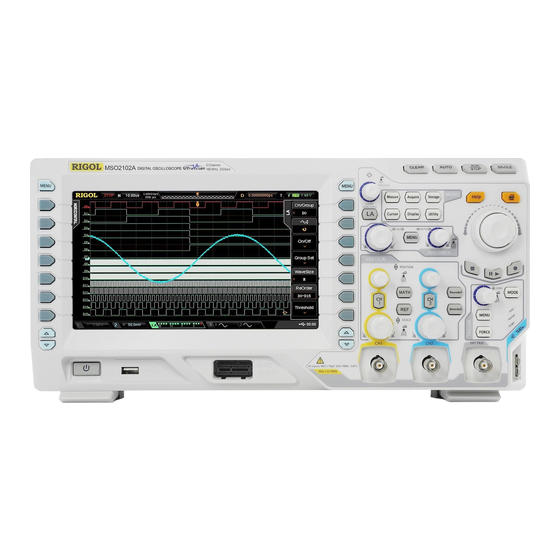
Table of Contents
Advertisement
RIGOL
Quick Guide
MSO2000A/DS2000A Series
Digital Oscilloscope
RIGOL(SUZHOU) TECHNOLOGIES INC.
May 2019
Distribution in the UK & Ireland
Lambda Photometrics Limited
Lambda House Batford Mill
Harpenden Herts AL5 5BZ
United Kingdom
E:
info@lambdaphoto.co.uk
W: www.lambdaphoto.co.uk
T:
+44 (0)1582 764334
F:
+44 (0)1582 712084
Advertisement
Table of Contents

Summarization of Contents
Safety Requirement
General Safety Summary
Key safety guidelines for instrument operation and user protection.
Safety Notices and Symbols
Explains warning/caution symbols and their meanings for safe use.
Measurement Category
Measurement Category Definitions
Defines supported measurement categories for oscilloscope use.
Ventilation Requirement
Ensure Adequate Ventilation
Instructions for maintaining airflow for instrument cooling and performance.
Working Environment
Operating Environment Conditions
Specifies operating temperature, humidity, altitude, and pollution degree limits.
Installation Overvoltage Category
Specifies the overvoltage category for the instrument's power input.
General Care and Cleaning
Instrument Care Guidelines
Guidelines for storing and protecting the instrument from direct sunlight.
Cleaning Procedure
Steps for safely cleaning the instrument's exterior and LCD screen.
Environmental Considerations
Product End-of-Life Handling
Recommendations for responsible recycling of the oscilloscope equipment.
Document Overview
Manual Format Conventions
Explains how buttons, menus, and operations are represented in the manual.
Content Conventions in this Manual
Model and Specification Conventions
Explains model naming and specification presentation within the manual.
Quick Start Guide
General Inspection Procedure
Steps for inspecting packaging, instrument, and accessories upon receipt.
Appearance and Dimensions
Physical Overview and Dimensions
Provides physical dimensions and front/top views of the oscilloscope.
Prepare for Operation
Adjust Supporting Legs
Guides on adjusting the oscilloscope's supporting legs for stable placement.
Connect to AC Power Supply
Instructions for connecting the oscilloscope to the AC power source correctly.
Turn-on Checkout
Initial Power-On and Self-Test
Procedure for powering on the instrument and its initial self-test sequence.
Connecting the Probe
Connect Passive Probe
Instructions for connecting passive probes to the oscilloscope's analog channels.
Connecting the Logic Probe
Logic Probe Connection Guide
Instructions for connecting logic probes to the oscilloscope's digital channels.
Function Inspection
Performing Function Inspection
Steps to verify basic oscilloscope functionality and probe connections.
Probe Compensation
Probe Compensation Procedure
Procedure for compensating probes to ensure accurate measurement results.
Front Panel Overview
Front Panel Controls and Interfaces
Detailed description of all front panel controls, buttons, and interface ports.
Rear Panel Overview
Rear Panel Components
Description of rear panel connectors and ports like LAN and USB.
Fuse Replacement
Instructions for safely replacing the instrument's fuse if needed.
AC Power and Connectivity
AC Power Cord Connector
Details the AC power input terminal and its electrical requirements.
USB Device Connection
Describes how to connect external devices via the USB port.
Trigger and Source Outputs
Explains the functionality of trigger out and source output ports.
Front Panel Function Overview
Vertical Controls
Explains vertical positioning and scaling adjustments for waveforms.
Horizontal Controls
Horizontal Time Base and Position
Explains adjustments for horizontal time base and trigger position.
Trigger Controls
Trigger Mode, Level, and Force
Details trigger modes, level adjustments, and force trigger functionality.
Basic Operation Keys
CLEAR, RUN/STOP, SINGLE, AUTO Keys
Explains the functions of CLEAR, RUN/STOP, SINGLE, and AUTO keys.
Knobs and Navigation
Multifunction and Navigation Knobs
Describes the function and usage of the instrument's various knobs.
Menu and Signal Source Settings
Menu Navigation and Softkeys
Explains how to navigate menus and use softkeys for settings.
Signal Source Output Configuration
Details how to configure and use signal source outputs.
Record and Print Functions
Waveform Recording and Playback
How to record waveforms and playback recorded data.
Screen Printing and Saving
How to print waveforms or save screens to a USB device.
Logic Analyzer Function
Logic Analyzer Operation
Details on using the logic analyzer, including channel control and display.
User Interface Overview
LCD Display and Measurement Items
Overview of the LCD display and how to activate auto measurement parameters.
Waveform Display Details
Digital Channel Display and Status
Explains digital channel labels, waveform colors, and status indicators.
Horizontal Time Base and Position
Details on horizontal time base, sample rate, and trigger position display.
Trigger Settings
Trigger Type, Source, and Level
Details on trigger types, sources, and level adjustments.
CH1 Vertical Scale Adjustment
Explains how to display and adjust CH1 vertical scale.
Channel and Source Waveforms
Analog and Digital Channel Details
Information on analog channel labels, CH2 vertical scale, and digital channel status.
Source1 and Source2 Waveforms
Details on source waveform types and modulation settings.
Notification Area and Operation Menu
Notification Area Icons
Explains system time, sound, and USB storage device icons.
Operation Menu Symbols
Details symbols used in the operation menu for parameter selection and adjustment.
Security Lock Usage
Securing the Instrument
How to use the security lock to fix the instrument's location.
Built-in Help System
Accessing Help Information
Guide to accessing and using the oscilloscope's help system via buttons or index.










Need help?
Do you have a question about the 100 and is the answer not in the manual?
Questions and answers